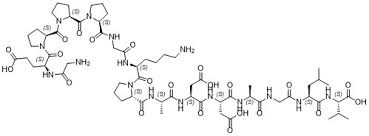
BPC-157 for Knee Pain
Share
BPC-157, a synthetic peptide derived from human gastric juice, has gained attention for its potential regenerative effects in musculoskeletal injuries, including knee pain. Preclinical studies in animal models consistently demonstrate that BPC-157 accelerates healing of tendons, ligaments, and muscle, likely through mechanisms involving enhanced angiogenesis, fibroblast migration, and modulation of growth factor pathways.[1-6] These effects have led to speculation about its utility in treating knee pain from various etiologies, such as osteoarthritis, ligament injuries, and tendinopathies.
Human data on BPC-157 for knee pain remain extremely limited. The only published clinical experience is a small retrospective case series involving intra-articular BPC-157 injections for knee pain of diverse causes. In this series, 11 of 12 patients who received BPC-157 alone reported significant pain improvement, and the overall response rate (including those who received BPC-157 with thymosin beta-4) was 87.5%. However, this study lacked standardized outcome measures, control groups, and objective imaging follow-up, and was not designed to assess safety or long-term efficacy.[7] No randomized controlled trials or large-scale observational studies in humans have been published to date.
Mechanistically, BPC-157 is thought to promote tissue repair by upregulating growth hormone receptor expression in tendon fibroblasts, enhancing cell survival under stress, and stimulating cell migration and outgrowth, as shown in animal and in vitro studies.[4-5] Animal models also suggest BPC-157 may facilitate muscle-to-bone reattachment and improve ligament healing, supporting its theoretical application in knee injuries.[8] Importantly, BPC-157 has demonstrated a favorable safety profile in preclinical studies, with no significant toxicity reported, but comprehensive human safety data are lacking.[9][10]
Despite its popularity in some alternative medicine and sports communities, BPC-157 is not approved by the FDA or other major regulatory agencies for any indication, including knee pain. The lack of robust clinical evidence and regulatory oversight means that its use should be considered experimental. The medical literature emphasizes the need for well-designed clinical trials to establish efficacy, optimal dosing, and safety in humans.[9]
In summary, while BPC-157 shows promise in preclinical models for enhancing soft tissue healing and has limited anecdotal support for knee pain relief, there is insufficient high-quality human evidence to support its routine use for knee pain at this time. Standard therapies for knee pain, such as physical therapy, NSAIDs, intra-articular corticosteroids, and surgical interventions, remain the mainstay of evidence-based management. Caution is warranted until further clinical research is available.[7][9]
1. Gastric Pentadecapeptide Body Protection Compound BPC 157 and Its Role in Accelerating Musculoskeletal Soft Tissue Healing.
Gwyer D, Wragg NM, Wilson SL.
Cell and Tissue Research. 2019;377(2):153-159. doi:10.1007/s00441-019-03016-8.
2. BPC 157 and Standard Angiogenic Growth Factors. Gastrointestinal Tract Healing, Lessons From Tendon, Ligament, Muscle and Bone Healing.
Seiwerth S, Rucman R, Turkovic B, et al.
Current Pharmaceutical Design. 2018;24(18):1972-1989. doi:10.2174/1381612824666180712110447.
3. Stable Gastric Pentadecapeptide BPC 157 and Wound Healing.
Seiwerth S, Milavic M, Vukojevic J, et al.
Frontiers in Pharmacology. 2021;12:627533. doi:10.3389/fphar.2021.627533.
4. Pentadecapeptide BPC 157 Enhances the Growth Hormone Receptor Expression in Tendon Fibroblasts.
Chang CH, Tsai WC, Hsu YH, Pang JH.
Molecules (Basel, Switzerland). 2014;19(11):19066-77. doi:10.3390/molecules191119066.
5. The Promoting Effect of Pentadecapeptide BPC 157 on Tendon Healing Involves Tendon Outgrowth, Cell Survival, and Cell Migration.
Chang CH, Tsai WC, Lin MS, Hsu YH, Pang JH.
Journal of Applied Physiology (Bethesda, Md. : 1985). 2011;110(3):774-80. doi:10.1152/japplphysiol.00945.2010.
6. Pentadecapeptide BPC 157 (PL 14736) Improves Ligament Healing in the Rat.
Cerovecki T, Bojanic I, Brcic L, et al.
Journal of Orthopaedic Research : Official Publication of the Orthopaedic Research Society. 2010;28(9):1155-61. doi:10.1002/jor.21107.
7. Intra-Articular Injection of BPC 157 for Multiple Types of Knee Pain.
Lee E, Padgett B.
Alternative Therapies in Health and Medicine. 2021;27(4):8-13.
8. Stable Gastric Pentadecapeptide BPC 157 as Therapy After Surgical Detachment of the Quadriceps Muscle From Its Attachments for Muscle-to-Bone Reattachment in Rats.
Matek D, Matek I, Staresinic E, et al.
Pharmaceutics. 2025;17(1):119. doi:10.3390/pharmaceutics17010119.
9. Multifunctionality and Possible Medical Application of the BPC 157 Peptide-Literature and Patent Review.
Józwiak M, Bauer M, Kamysz W, Kleczkowska P.
Pharmaceuticals (Basel, Switzerland). 2025;18(2):185. doi:10.3390/ph18020185.
10. Stable Gastric Pentadecapeptide BPC 157 as a Therapy and Safety Key: A Special Beneficial Pleiotropic Effect Controlling and Modulating Angiogenesis and the NO-System.
Sikiric P, Seiwerth S, Skrtic A, et al.
Pharmaceuticals (Basel, Switzerland). 2025;18(6):928. doi:10.3390/ph18060928.
